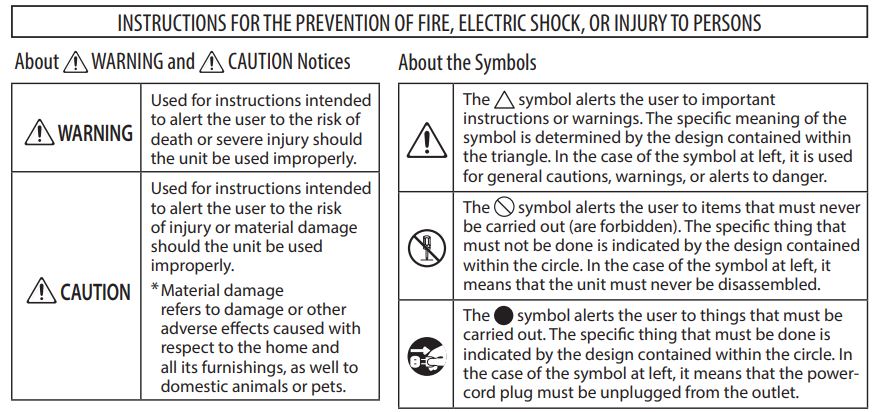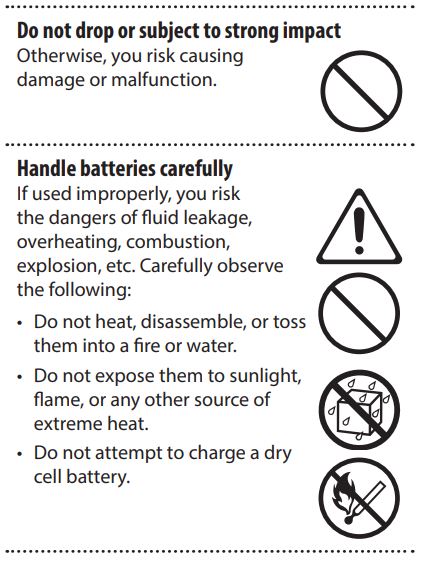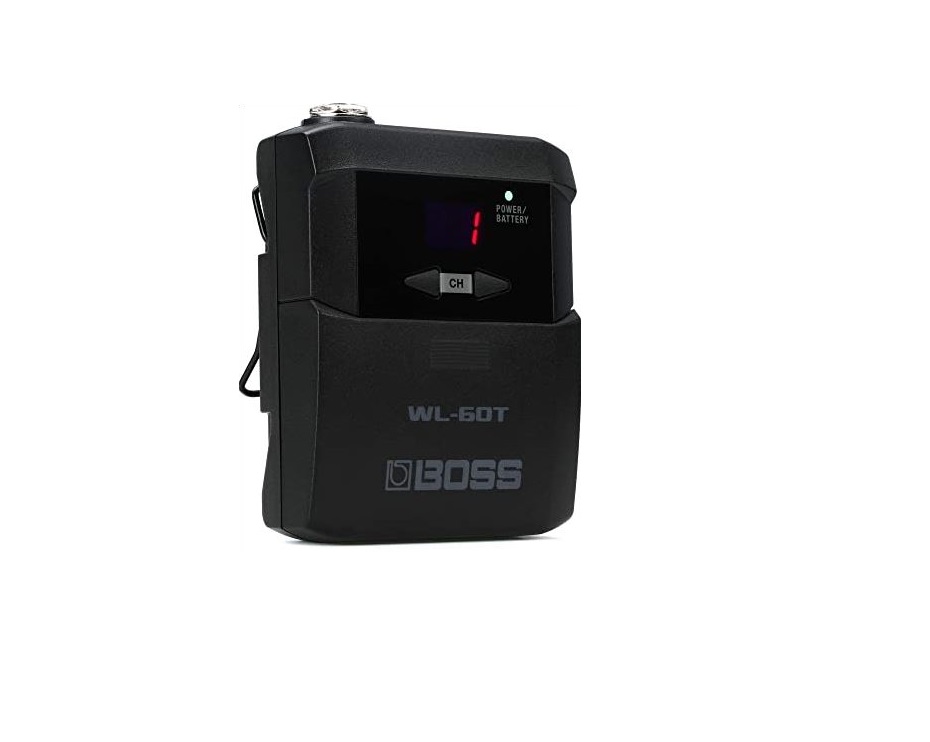BOSS WL-60T Wireless Transmitter Manual

For details on how to use the WL-60T, refer to the owner’s manual of the wireless system product that you’re using.
USING THE UNIT SAFELY

ALWAYS OBSERVE THE FOLLOWING
⚠ WARNING
 Do not disassemble or modify by yourself Do not carry out anything unless you are instructed to do so in the owner’s manual. Otherwise, you risk causing malfunction.
Do not disassemble or modify by yourself Do not carry out anything unless you are instructed to do so in the owner’s manual. Otherwise, you risk causing malfunction.
 Do not repair or replace parts by yourself Be sure to contact your dealer, a Roland service center, or an official Roland dealer.
Do not repair or replace parts by yourself Be sure to contact your dealer, a Roland service center, or an official Roland dealer.
For a list of Roland service centres and official Roland dealers, refer to the Roland website.
Do not use or store in the following types of locations

- Subject to temperature extremes (e.g., direct sunlight in an enclosed vehicle, near a heating duct, on top of heat-generating equipment); or are
- Damp (e.g., baths, washrooms, on wet floors); or are
- Exposed to steam or smoke; or are
- Subject to salt exposure; or are
- Exposed to rain; or are
- Dusty or sandy; or are
- Subject to high levels of vibration and shakiness; or are
- Placed in a poorly ventilated location.
 Do not place in an unstable location Otherwise, you risk injury as the result of the unit toppling over or dropping down.
Do not place in an unstable location Otherwise, you risk injury as the result of the unit toppling over or dropping down.
 Use only the specified AC adaptor and the correct voltage Use only the specified AC adaptor, and make sure the line voltage at the installation matches the input voltage specified on the AC adaptor’s body.
Use only the specified AC adaptor and the correct voltage Use only the specified AC adaptor, and make sure the line voltage at the installation matches the input voltage specified on the AC adaptor’s body.
 Do not allow foreign objects or liquids to enter unit; never place containers with liquid on unit Do not place containers containing liquid (e.g., flower vases) on this product. Never allow foreign objects (e.g., flammable objects, coins, wires) or liquids (e.g., water or juice) to enter this product. Doing so may cause short circuits, faulty operation, or other malfunctions.
Do not allow foreign objects or liquids to enter unit; never place containers with liquid on unit Do not place containers containing liquid (e.g., flower vases) on this product. Never allow foreign objects (e.g., flammable objects, coins, wires) or liquids (e.g., water or juice) to enter this product. Doing so may cause short circuits, faulty operation, or other malfunctions.
⚠ Turn off the unit if an abnormality or malfunction occurs In the following cases, immediately turn off the power and contact your dealer, a Roland service center, or an official Roland dealer for service.
- If smoke or unusual odor occurs; or
- Objects have fallen into, or liquid has been spilled onto the unit; or
- The unit has been exposed to rain (or otherwise has become wet); or
- The unit does not appear to operate normally or exhibits a marked change in performance.
For a list of Roland service centres and official Roland dealers, refer to the Roland website.
⚠ Be cautious to protect children from injury Always make sure that an adult is on hand to provide supervision and guidance when using the unit in places where children are present, or when a child will be using the unit.
 ⚠ CAUTION
⚠ CAUTION
 When disconnecting the power cord, grasp it by the plug To prevent conductor damage, always grasp the power cord by its plug when disconnecting it.
When disconnecting the power cord, grasp it by the plug To prevent conductor damage, always grasp the power cord by its plug when disconnecting it.
⚠Route all power cords and cables in such a way as to prevent them from getting entangled Injury could result if someone were to trip on a cable and cause the unit to fall or topple.
![]() Avoid climbing on top of the unit, or placing heavy objects on it Otherwise, you risk injury as the result of the unit toppling over or dropping down.
Avoid climbing on top of the unit, or placing heavy objects on it Otherwise, you risk injury as the result of the unit toppling over or dropping down.
![]() Never connect/disconnect a power plug if your hands are wet Otherwise, you could receive an electric shock.
Never connect/disconnect a power plug if your hands are wet Otherwise, you could receive an electric shock.
 Disconnect all cords/cables before moving the unit Damage or malfunction may result if you fail to disconnect all cables before moving the unit.
Disconnect all cords/cables before moving the unit Damage or malfunction may result if you fail to disconnect all cables before moving the unit.
⚠![]()
 Handle batteries carefully If used improperly, batteries may explode or leak and cause damage or injury. In the interest of safety, please read and observe the following precautions.
Handle batteries carefully If used improperly, batteries may explode or leak and cause damage or injury. In the interest of safety, please read and observe the following precautions.
- Carefully follow the installation instructions for batteries, and make sure you observe the correct polarity.
- Avoid using new batteries together with used ones. In addition, avoid mixing different types of batteries.
- Remove the batteries whenever the unit is to remain unused for an extended period of time.
- Never keep batteries together with metallic objects such as ballpoint pens, necklaces, hairpins, etc.
- Used batteries must be disposed of in compliance with whatever regulations for their safe disposal that may be observed in the region in which you live.
Handle leaking batteries carefully
⚠
- Do not touch the liquid with your bare hands.
- If any of the leaking fluid gets into your eyes, the loss of vision may result. Do not rub your eyes; use clean water to flush them thoroughly. Then, promptly see a doctor.
- Burning of the skin or dermatitis may result if fluid has gotten onto your skin or clothing. Use clean water to flush affected areas thoroughly; then, promptly see a doctor.
- Using a soft cloth, carefully wipe any remaining fluid from the inside of the battery compartment. Then, install new batteries.
IMPORTANT NOTES
Power Supply: Use of Batteries
- Before installing/removing batteries, make sure to turn off the power to this unit and disconnect all connections to other devices.
- The life of the supplied batteries may be limited, since its primary purpose was to enable testing.
If operating this unit on batteries, please use alkaline batteries.
Placement
- Using the unit near power amplifiers (or other equipment containing large power transformers) may induce hum. To alleviate the problem, change the orientation of this unit; or move it farther away from the source of interference.
- This unit may interfere with radio and television reception. Do not use this unit in the vicinity of such receivers.
- Noise may be produced if wireless communications devices, such as cell phones, are operated in the vicinity of this unit. Such noise could occur when receiving or initiating a call, or while conversing. Should you experience such problems, you should relocate such wireless devices so they are at a greater distance from this unit, or switch them off.
- When moved from one location to another where the temperature and/or humidity is very different, water droplets (condensation) may form inside the unit. Damage or malfunction may result if you attempt to use the unit in this condition. Therefore, before using the unit, you must allow it to stand for several hours, until the condensation has completely evaporated.
- Do not place containers or anything else containing liquid on top of this unit. Also, whenever any liquid has been spilled on the surface of this unit, be sure to promptly wipe it away using a soft, dry cloth.
Maintenance
- Never use benzine, thinners, alcohol or solvents of any kind, to avoid the possibility of discoloration and/or deformation.
Additional Precautions
- Use a reasonable amount of care when using the unit’s buttons, sliders, or other controls; and when using its jacks and connectors. Rough handling can lead to malfunctions.
- Never strike or apply strong pressure to the display.
- When disconnecting all cables, grasp the connector itself–never pull on the cable. This way you will avoid causing shorts, or damage to the cable’s internal elements.
- Do not use connection cables that contain a built-in resistor.
- When turning the unit over, be careful so as to protect the buttons and knobs from damage. Also, handle the unit carefully; do not drop it.
Caution Regarding Radio Frequency Emissions
- The following actions may subject you to penalty of law.
- Disassembling or modifying this device.
- Removing the certification label affixed to the back of this device.
- Using this device in a country other than where it was purchased
- Do not use this product closer than 22 cm (811/16 inches) from where a cardiac pacemaker is implanted. Doing so may a ect the operation of the cardiac pacemaker.
Licenses/Trademarks
- Roland and BOSS are either registered trademarks or trademarks of Roland Corporation in the United States and/or other countries.
- Company names and product names appearing in this document are registered trademarks or trademarks of their respective owners.


European Community Declaration of Conformity
Hereby, Roland Corporation declares that the radio equipment type wireless transmitter is in compliance with Directive 2014/53/EU. The full text of the EU declaration of conformity is available at the following internet address.
The Declaration of Conformity may be consulted in Downloads menu of this product at the following internet address. This unit has an RF transmitter(s) with the following specification.
- Operating frequency: 24002483.5 MHz
- Maximum RF transmit power: 16.0 mW https://roland.cm/bossRED_DoC
For the USA
This transmitter must not be co-located or operated in conjunction with any other antenna or transmitter. (FCC Part15 Subpart C §15.247, 15.253, 15.255)
This equipment complies with FCC radiation exposure limits set forth for an uncontrolled environment and meets the FCC radio frequency (RF) Exposure Guidelines as this equipment has very low levels of RF energy.
(FCC Part15 Subpart C §15.247, 15.253, 15.255)
For Canada This device contains licence-exempt transmitter(s)/receiver(s) that comply with Innovation, Science and Economic Development Canada’s licence-exempt RSS(s). Operation is subject to the following two conditions: 1. This device may not cause interference. 2. This device must accept any interference, including interference that may cause undesired operation of the device.
This equipment complies with ISED radiation exposure limits set forth for an uncontrolled environment and meets RSS-102 of the ISED radio frequency (RF) Exposure rules as this equipment has very low levels of RF energy.
FEDERAL COMMUNICATIONS COMMISSION RADIO FREQUENCY INTERFERENCE STATEMENT
For the USA
This equipment has been tested and found to comply with the limits for a Class B digital device, pursuant to Part 15 of the FCC Rules. These limits are designed to provide reasonable protection against harmful interference in a residential installation. This equipment generates, uses, and can radiate radio frequency energy and, if not installed and used in accordance with the instructions, may cause harmful interference to radio communications. However, there is no guarantee that interference will not occur in a particular installation. If this equipment does cause harmful interference to radio or television reception, which can be determined by turning the equipment off and on, the user is encouraged to try to correct the interference by one or more of the following measures:
Reorient or relocate the receiving antenna. Increase the separation between the equipment and receiver. Connect the equipment into an outlet on a circuit different from that to which the receiver is connected. Consult the dealer or an experienced radio/TV technician for help.
This device complies with Part 15 of the FCC Rules. Operation is subject to the following two conditions: (1) this device may not cause harmful interference, and (2) this device must accept any interference received, including interference that may cause undesired operation.
This equipment requires shielded interface cables in order to meet FCC class B limit. Any unauthorized changes or modifications not expressly approved by the party responsible for compliance could void the user’s authority to operate the equipment.
CAN ICES-3 (B)/NMB-3 (B)
![]() Manufacturer: Roland Corporation 2036-1 Nakagawa, Hosoe-cho, Kita-ku, Hamamatsu, Shizuoka 431-1304, JAPAN
Manufacturer: Roland Corporation 2036-1 Nakagawa, Hosoe-cho, Kita-ku, Hamamatsu, Shizuoka 431-1304, JAPAN
Importer: Roland Corporation ENA 23 Zone 1 nr. 1620 Klaus-Michael Kuehnelaan 13, 2440 Geel, BELGIUM
![]() Manufacturer: Roland Corporation 2036-1 Nakagawa, Hosoe-cho, Kita-ku, Hamamatsu, Shizuoka 431-1304, JAPAN
Manufacturer: Roland Corporation 2036-1 Nakagawa, Hosoe-cho, Kita-ku, Hamamatsu, Shizuoka 431-1304, JAPAN
Importer: Roland Europe Group Limited Hive 2, 1530 Arlington Business Park, Theale, Reading, Berkshire. RG7 4SA United Kingdom
![]() This symbol indicates that in EU countries, this product must be collected separately from household waste, as defined in each region, products bearing this symbol must not be discarded together with household waste.
This symbol indicates that in EU countries, this product must be collected separately from household waste, as defined in each region, products bearing this symbol must not be discarded together with household waste.
Roland Service Centers and Distributors
When you need repair service, access this URL and find your nearest Roland Service Center or authorized Roland distributor in your country.

